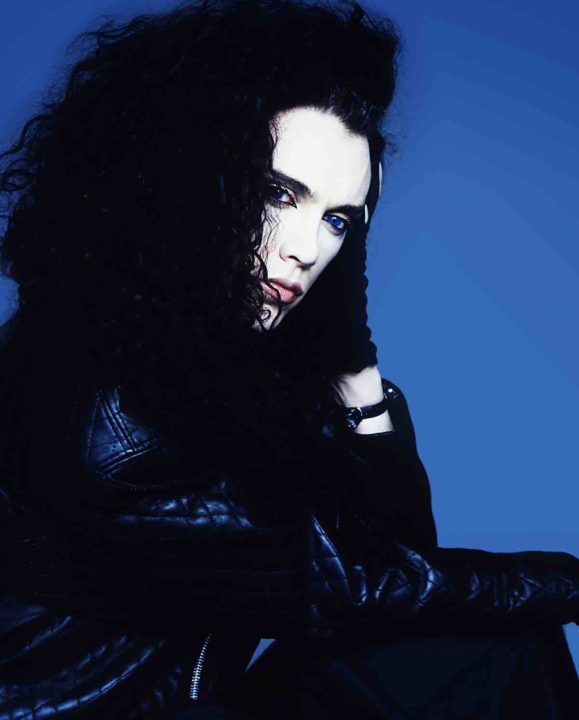
As the lead singer of Dead Or Alive, Pete Burns was one of pop’s most arresting figures. In 2016, on the eve of the release of a Dead Or Alive boxset, Classic Pop decided to reassert the importance of Pete Burns as an influential artist – and then, just four weeks later, he tragically died. Here is the last-ever interview with a shining star of British pop music…
On Saturday 17 September 2016, I interviewed Pete Burns for Classic Pop. The aim was to reclaim Dead Or Alive as a musical force after years – decades, even – of Burns being at best dismissed, at worst pilloried, as a freakshow, because of his desire to reshape his appearance.
The intention was to base the interview not on his history of face-altering operations, but on his musical trajectory, encouraged by the release of the 19-disc Dead Or Alive boxset, Sophisticated Boom Box MMXVI.
The interview took place over the phone, presumably because of his discomfort at being judged on his physiognomy, especially in the wake of the Channel 5 documentary Celebrity Botched Up Bodies, which had aired a few days earlier.
Burns was in lively, candid, albeit slightly anxious form. I wrote up the feature, sent it in to Classic Pop’s editor, and that was that… until Monday 24 October, when the news broke that Burns had died following a massive cardiac arrest.
And so the article, written in the present tense, had to be rewritten, to take into account his tragic death. What follows is a feature based on our hour-long encounter, now placed in the past and afforded a roseate glow. He was the self-styled ‘King Punk’ and, for his merciless verbal annihilations of those he disliked, ‘Queen Bitch’.
He was a brilliant pop performer and singer and songwriter of some note, and in the annals of freak-flag flyers, he was up there with the best. As Boy George declared after his death: “He was a cross between Oscar Wilde and Dorothy Parker. You don’t get more brilliant than that.”
Dead Or Alive: Pete Burns interview
Traditionally, one associated Pete Burns with many things – outrage, flamboyance, provocation, controversy… self-doubt never being one of them. However, this time, a proper sit-down encounter with a music magazine, not a tabloid newspaper or scandal sheet, was putting him on edge.
In fact, the first few minutes speaking to Burns featured a torrent of anxious admissions. He hadn’t had a wink of sleep; he hadn’t done an interview for ages – “I haven’t been speaking to anybody”. He’d had a “really bad time with kidney stones and stuff”. He’d moved into a flat “that I absolutely hate – I’m moving out at the end of the month.”
I reassured him that Classic Pop’s method was not to pry or debunk, but to celebrate the era from which Burns emerged as the androgynous apotheosis, with his group Dead Or Alive. But even this made him uneasy.
“I’m just really nervous about talking about a product,” he said of Sophisticated Boom Box MMXVI, the 19-disc boxset of Dead Or Alive’s work (including rarities, remixes and entire albums previously unavailable in the UK), in his familiar Scouse brogue.
“Normally when I had a product out I didn’t used to promote it; I used to let it sink or swim on its own.” I explained that I simply wanted to discuss his music and influence. “Oh, I’m just gonna be shit,” he stammered. “I’m just gonna be shit…”
Read more: The Lowdown – Echo & The Bunnymen
Notwithstanding his fearsome reputation as a provocateur, hearing him speak like this couldn’t help making you want to bundle him up and give him a cuddle. Fortunately, he was dressed accordingly.
“I’ve got on a pair of Incredible Hulk pyjamas,” he admitted. “And I’ve had a terrible night. I suffer from crippling insomnia. No pill will touch it, so I have to go with it. I’ve been awake all night, pacing the flat.”
Before we turned to the matter of the boxset, the subject had to be broached: there had been rather a lot of attention in recent years on his appearance…
“Well, in a way it was lucky I had my appearance because it kept me afloat in times when there was no album,” he reasoned of his transition from gregarious pop singer to garish reality TV star.
“It was something people wanted to talk about, but I got sick of talking about it. So I don’t do many of those [interviews] now. It’s like having to explain yourself after you’ve done something. I’ve never felt the need, after I’ve made a record, to explain myself. If people have bought it they’ve bought it and I’m very grateful for that. If they haven’t, then I don’t feel I’ve brainwashed them into buying it.”
Dead Or Alive: Pete Burns interview
I ventured that it was a shame not to talk about Dead Or Alive, because they have been written out of history and deserve a place in the 80s pantheon.
“I definitely agree,” he said, “but in an ideal world that shouldn’t be dependent on me talking about it. The music should speak for itself.”
Burns started out as a clothes designer and the proprietor of Liverpool shop Probe, which catered, as did Sex in London, to the city’s nascent punk scene. Apparently, he used to tell customers the clothes they’d just bought were “crap”. Julian Cope of Teardrop Explodes later recalled him mocking people he spotted around town wearing his designs.
His approach to music was equally outrageous. His first band was Mystery Girls, named after a New York Dolls song and featuring Pete Wylie – later of Wah! Heat – and Cope, who claimed Burns’ performance style was based on infamous US transgender glam-punk Wayne/Jayne County.
Burns’ next foray was Nightmares in Wax, originally named Rainbows Over Nagasaki, whose sole EP was titled Birth Of A Nation, after DW Griffith’s notoriously racist 1915 film. It included a track called Black Leather (“It was a one-off attempt at disco but the bass player couldn’t play it,” Burns said tartly).
Of Nightmares In Wax’s proto-goth sound, he said: “It was the only music we could make because we didn’t have a synthesiser or sequencer. It wasn’t what I wanted to be doing. I imagined the music sounding like Donna Summer when it was finished! And it never did.”
Dead Or Alive: Pete Burns interview
Even after Nightmares In Wax had morphed into Dead Or Alive, they still sounded less like Donna than The Doors. They were a sort of northern answer to Southern Death Cult (with Wayne “The Mission” Hussey briefly in their ranks).
If they had peers or likeminds in Liverpool, it would have been Echo & The Bunnymen. “Oh, I wish we were as good as the Bunnymen,” Burns sighed. “The Bunnymen’s records were so good, and mine were so dour.”
We discussed the Liverpool scene. It was incestuous and intense, hardly surprising considering its prime movers: Holly Johnson (later of Frankie Goes To Hollywood), Ian (Lightning Seeds) Broudie, Bill (KLF) Drummond, Jayne (Pink Military) Casey, Budgie (Siouxsie & The Banshees), Cope, Wylie, McCulloch…
“I vaguely knew McCulloch,” Burns confirmed. “We weren’t friends or anything, but I met them all. It was a very incestuous scene but I was outside of it because of my appearance – it was so flamboyant, I was ostracised.” He was an outsider… even during post-punk? “Yeah, because they were into grey raincoats,” he said of post-punk’s dour uniform, and his peacock alternative.
Surely he was friends with Johnson and Casey?
“We were frenemies,” he replied. “I didn’t get on with them. We were all wankers, protective of our own thing. Never the twain shall meet. We kept to ourselves. I was very insular. I still am – I don’t socialise or mix or belong to any scene. I’d go as far as to say I’m a hermit or a recluse. I conducted my life in that manner back then.”
Dead Or Alive: Pete Burns interview
How difficult was it, looking like he did? Were there threats of physical violence?
“No, because I became an icon,” he said, matter-of-factly. “People would travel from Wales and Leeds, just to look at me. They used to call me King – I was like King Punk. So it was very safe for me to look like that.
“Because my appearance was so extreme I was deified in the clubs I went to,” he continued. “I’d be in the VIP section, or taken backstage to meet bands like the Sex Pistols. We didn’t write each other postcards or anything like that. But I did get on with them.”
Few 80s groups changed so dramatically as Dead Or Alive, who between 1981 and ‘84 went from Peel session band to PWL production progeny. With Burns “more into Sylvester than the Sex Pistols”, DOA were harbingers of hi-NRG on 1984 debut album Sophisticated Boom Boom. Burns insisted that DOA’s metamorphosis was “natural, organic”.
With a bit of record company money, the band acquired a sequencer “and suddenly the same basic songs [that we’d been writing] had a whole different vibe”.
Yet while Burns would have an idea of the sound he wanted for DOA, the reality would never match up – not even their biggest hit, the Stock Aitken Waterman-helmed You Spin Me Round (Like A Record), a worldwide No.1 in 1985, came close to realising his dream of the perfect record.
“I always wanted to make a record that was up to [the disco classics], and I don’t think I ever did,” he said, somewhat sadly. “People think Spin Me was – that’s become a classic. But I’m not satisfied with any piece of work that I’ve done.” He did, however, describe Sophisticated Boom Boom as “the most joyous experience of my life, full of happy memories, because there was no commercial pressure on us.”
Dead Or Alive: Pete Burns interview
It was a great time for music, period, although instead of finding common ground, the press were keener to manufacture feuds, principally between Burns, Boy George and Marilyn.
“Those [disputes] were completely press-invented,” Burns said (he’d bumped into Marilyn “the other day” and there had been hugs all round). “At the moment the press are doing things because I did this plastic surgery show [Channel 5’s Celebrity Botched Up Bodies] and they’ve been saying things about me like I’ve got psychiatric issues and stuff,” he added. “Because I don’t speak for myself, the press attack me a lot.”
But did Burns agree that the early 80s were a golden age? “Definitely,” he said, happy to seek solace in the past. “There were no stylists, there was no fashion catwalk stuff, there was no set sound… to be honest with you, I haven’t heard a record since Girls Aloud’s [2008 single] The Promise that’s caught my ear.”
The very pop perfection of a record like The Promise was what caused Burns to doubt the sound of Dead Or Alive’s music in their later years – there had only been three albums since 1990, and even those remained unissued in the UK until the box set.
Read more: The Myth Factory – Stock Aitken Waterman
Top 40 Stock Aitken Waterman songs
Burns’ perfectionist – or maybe just highly self-critical – streak made him want to keep messing with his recordings, and doubt even his best work. He similarly spent years tweaking his appearance with multiple cosmetic surgery operations.
“To me there’s something I can’t verbalise that’s missing,” he said of hits such as You Spin Me Round, but he could have been talking about his face.
Was he seeking perfection? “Not perfection, just personal satisfaction,” he replied. “But I don’t know what that is… I’m never satisfied. I don’t own any of my work because as far as I’m concerned I’ve done it. And once I’ve done it I’ve done it. I never listen to any of it. I made it, and all I can hear are the faults.”
Dead Or Alive: Pete Burns interview
When was the last time that he played, for example, DOA’s second album, Youthquake, the one featuring You Spin Me Round?
“Probably the day I finished making it,” he answered, “because Youthquake is the album I was most dissatisfied with. I don’t feel I came out of the SAW experience having learned anything, other than that the recording industry was a business and you can have a hit and everything has to sound the same way.
“One of the unhappiest days of my life was when Spin Me reached No.1 – and I mean really unhappy. Because I knew it would be downhill all the way after that.”
He didn’t exactly try to sabotage his success, he said, but he did find himself hoping and praying his subsequent singles didn’t chart as highly. “I didn’t want too high positions because I didn’t want to lose my life,” he recalled. True fame scared him: “I thought, if it happens it happens, but if it doesn’t – phew!”
Did he enjoy anything about his peak moment of mid-80s pop fame?
“There were so many of them, they got to be a chore,” he said with another sigh. “When I got my first royalty cheque I was on top of the world because I could go and buy myself a flat in Holland Park [upmarket West London district]. But after that my mother got cancer and all kinds of things went on in my personal life that soured the rest of the experience, really. I had to make a choice,” he added, “between what’s going on in your actual life and what’s going on on the cover of Smash Hits. I chose life.”
Following his mother’s death, Burns’ life collapsed into disarray. “I felt, well, nothing’s worth going on for,” he revealed. “I had a nervous breakdown after she died and couldn’t work.”
DOA had one more UK-charting album with 1987’s Mad, Bad, And Dangerous To Know. He enjoyed celebrity thereafter in Japan, where he was bigger than Michael Jackson and Madonna. The band’s 1989 single Turn Around And Count 2 Ten spent 17 weeks there at No.1.
“It was fantastic to have all the success and glory in Japan,” he said. “I had the army as bodyguards when I went jogging. That was surreal – I knew in two weeks I’d be back home, jogging on my own at the gym.”
Read more: Top 15 Stock Aitken Waterman albums
Read more: Making Frankie Goes To Hollywood’s Welcome To The Pleasuredome
And what kind of reactions did he get on the street in the wake of his appearances on UK reality TV shows? “Very good reactions – people are very nice to me,” he said, and then reconsidered. “At the moment I’m in an area of London where people are not so nice to me. They recognise me too much and if I sit down for a coffee someone will come and join me which I find intrusive because I’m not always ‘on’, if you know what I mean. But I’ve got to cooperate and give them a selfie.”
Did he, like Greta Garbo, “vont to be alone”? “No, it’s meant to be this way.”
Did he have any regrets? “Actually, for somebody who should technically have lots, I don’t have regrets,” he decided. “I’ve done what I’ve done and there still is a loyal audience out there.”
Burns said he didn’t, however, “understand the fascination with me”. “I didn’t think anyone could make such a fuss out of me changing my appearance,” he added. “I just thought it was something you were allowed to do. It’s artistic expression.” Clearly, he was still hurt by the reactions to the Channel 5 documentary, and its insinuation that he had “psychiatric issues”.
Was he, I enquired, completely sane? “Well,” he came back, “who is completely sane? Are you?” I replied “no” – and Pete Burns laughed for the first time that day.
I went through a list of all the 80s pop stars known to have suffered as a direct result of their success: Adam Ant, Nick Heyward, Phil Oakey, Billy Mackenzie, Martin Fry… they all found fame and the fall-out hard to deal with, some having breakdowns. Burns seemed amazed by my surprise.
“Well, of course it’s not the answer to everything,” he barked of success and its empty trappings, with just a frisson of that fearsome bitchiness.
“Money’s not the answer to everything. Riches aren’t the answer to everything. The answer to everything is inner happiness. I’m still looking for that.”
Read Classic Pop’s obituary for Pete Burns here
Classic Pop may earn commission from the links on this page, but we only feature products we think you will enjoy.


